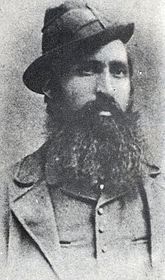
The Making of a Southern Briganti
By Tom Frascella July 2016
Preface
In writing about early Lucanian/San Felese migration to the United States it is important to understand that those who immigrated to the U.S from 1860-1880 were primarily “political” refugees. In a strange turn of political expedience southern Italians of this time were forced to seek refuge from an oppressive regime that in fact they had helped obtain power and create a new “unified” Italy. Once in power over southern Italy Piedmont declared many of the pro-republican, pro-Mazzinians that had actively helped Garibaldi in wresting control from the Bourbons, enemies of the new unified State and outlaws. In southern Italy, these politically disfavored would come to be known or labelled “Briganti” by the Piedmont regime. To be clear these men initially expected to be rewarded for their efforts by the “new” unified government as patriots. Instead the regime declared “war” on these men in an effort to eliminate their potential pro-republican voice. These actions by the Piedmont regime in effect amounted to an undeclared war waged against former compatriots. A Civil war orchestrated by Piedmont against men who had been political allies. By purposeful acts and direct order Piedmont ushered in and encouraged its military to use the most brutal and despicable of actions and treatment against those newly declared enemies. That undeclared war by Piedmont would eventually expand to include the families and often whole villages associated with the Piedmont declared enemies of the State. Piedmont shielded its true actions against the people of the south by declaring these men Briganti or outlaws. By associating these newly minted “outlaws” with common criminals Piedmont disguised the political nature and history of these new enemies of the unified Italy. But it must be understood that it was Piedmont that declared war on them not the other way around. As the briganti of the south resisted the injustice, the entire region soon became enveloped and victimized by the Piedmont war.
The rise of the post Bourbon Briganti of southern Italy would ultimately have profound implications for all Lucanians, men women and children. It is not possible to understand the true causes of the migration of mid-19th century Lucanians to the U.S. without understanding first the nature and history of what the Piedmont regime did to rid the country of so-called southern Briganti after the war of Unification. I hope that this article helps explain the term briganti’s origin as well as how it came to be used by Piedmont and associated with southern Italians especially those of Lucanian origin. The post-unification use of the term in reference to southern Italians has had social, cultural and negative racial impact on the people of Lucania. Those negative impacts and the burden of being labelled “criminals” are still being felt today both in Italy and in the U.S.
The Bourbon Kingdom of Naples, Briganti 1700-1800
By way of history for those unfamiliar with the term, originally the term Briganti was roughly the Italian equivalent of the English word brigand or outlaw. Up until the late 18th century a southern Italian Briganti was something like what the English would call a highwayman. In the hills and mountains of rural Lucania individuals or small gangs would occasionally hold up/rob travelers and merchants moving along mountain trails and then flee to the sanctuary of isolated mountain retreats. Sort of like Jesse James or the Hole in the Wall gang in the American West who would hold up a stage coach and then flee into the badlands. Like the American West most of the time the robberies were petty in nature and infrequent. Also like the American West the number of people engaged in this activity was very small, a few dozen over a large mountainous state. Probably between 1600 and 1800 the number of people engaged in such activities never exceeded a scattered 100 at any given time out of a Basilicatan population of 400,000-500,000 people. For the authorities, since there were so few incidents it was more trouble to hunt the offenders down than the effort was worth. So their insignificance usually helped provide them with a measure of freedom from pursuit. Their lives were lives of hardship separated from their homes, families and the companionship of the people who they grew up with. It was not a lifestyle anyone embraced. As to the individuals who comprised the briganti of the 17th and early 18th century they were usually people accused of local petty theft or violent assault due usually to disputes that included some affront to a female.
Not the Mafia or Camorra
Some writers on the subject of the briganti have either intentionally or through misunderstanding confused the subject of southern briganti with the more well-known criminal activities of the Sicilian based Mafia or its Neapolitan equivalent the Camorra. For my purposes of comparison I am writing mostly on the briganti element resident in the Apennine Mountains of southern Italy, an area I will call greater Lucania. This is an area in which geographically San Fele is roughly centrally located.
The Sicilian Mafia or Neapolitan Camorra are both well-known organized criminal enterprises with centuries old existence in their traditional regional areas of operation. They have prospered in regions that have significant economic activity from which they can leech their proceeds. Their existence and point of operation is the rich urban areas of coastal southern Italy and Sicily. One can say that in order to have successful organized crime one must also have successful legal enterprise from which to profit.
Traditionally the rural Apennine Mountains of southern Italy have never been fertile ground for such organized criminal activity. Rugged mountainous terrain with small scattered populations and little or no commercial activity simply doesn’t support such criminal organization. The Italian State of Basilicata has been the poorest Italian State for the last 500 years up to and including today. There was so little economic resource among the middle and poor classes that there was no theft beyond petty theft. Organized crime did not exist in Lucania. In fact, Italian organized crime experts maintain that there was no organized crime presence in Basilicata until 1980, a mere thirty-five years ago. Even then the criminal syndicates were imported from outside the region in order to syphon off government and humanitarian aid which was following into Basilicata at the time. This sudden influx of aid in 1980 was relief aid for the Basilicatan people suffering from the major regional earthquake of 1980. The infusion of money and relief meant that there was something for organized crime syndicates in other parts of Italy to steal. These external criminal elements which have always maintained tight governmental ties in Italy moved into Basilicata to further their ill-gotten profit motive, not the needs of locals. In fact I can remember the efforts of central New Jersey’s Italian American community in the earthquake aid effort. I also remember that at some point we were advised to stop sending relief packages because relief packages and such were not reaching the people but were being stolen in transit. So to make it abundantly clear as southern Lucanian “briganti” is defined here they neither historically nor in any modern scenario of this narrative had any relationship with organized crime accept for an antagonistic one.
The Briganti of the 19th Century Bourbon Kingdom of the Two Sicilies
Starting in the late 18th century in the rural outback of southern Italy a new type of government “declared” crime and individual began to appear among the more traditional petty criminal southern Briganti. This was a time when great political unrest began to emerge in the form of a movement that eventually was called the Carbonari movement. Between about 1780 and 1850 small isolated revolts against the Bourbon regime flared up in the south. These poorly organized and equipped revolts generally were easily put down or collapsed. The men who participated, usually middle-class individuals were either imprisoned for their actions, exiled to foreign lands, or sought refuge in the sparsely inhabited mountains of southern Italy. Those seeking mountain refuge were few in number and again presented little political/revolutionary threat to the regime. However, as they were “political” revolutionaries living outside of the laws of the state they too were branded “briganti”. So for the first time in the southern historical record some “political” insurgents became merged with the purely criminal based briganti/highwaymen as labelled by the government authorities. However, these men shared little in either action or motivation, other than hiding from the authorities with the criminal element and generally did not work in concert.
As the revolutionary pro republican, pro unification movement in Italy grew and transformed into the Mazzinian inspired “Young Italia” movement of the 1830’s the minor revolts continued without much success in the south. This included the 1848 uprising. Looking solely at the situation of banditry in southern Italy’s Basilicata region, by 1857 there were no more than approximately 250 men living an outlaw, brigand life in the southern Apennine. Of those about 80% were run of the mill criminals and only 20% at most political outlaws. This is not a large number in a State with 400,000-500,000 people. It has to be remembered that the political activism of the period in the south was middle-class organized and led. This meant that when pressured most of the political opponents of the Bourbon regime had the where with all to flee to other parts of Italy and Europe, not hide up in the mountains. Again since the relatively small number of men so engaged meant they constituted only minor concern or threat to Bourbon civil authority little was done to apprehend them. Up until 1857 the Bourbon authorities made little serious effort to eradicate what to them was a low priority and relied on local authority to maintain control and order.
The Great Neapolitan Earthquake of December 1857
Interestingly, in 1857 Bourbon controlled southern Italy, what changed the briganti situation was not caused by petty criminal uptick or revolutionary action. What transformed the Basilicatan briganti landscape was a single event, the Great Neapolitan earthquake of 1857. This earthquake was centered in Basilicata, within the span of 48 hours killing 20,000 people, displacing or making homeless tens of thousands more, and devastating the fragile economics of the region. Frustrated by a total lack of aid from the central government the starving Lucanian masses began to riot and loot. The Bourbon response was to send in troops to “pacify” the region and declare “criminal” the peoples’ acts of survival and desperation. As a result of the Bourbon choice to use the stick rather than a humanitarian “carrot” many honest men were declared briganti. Also as a result of the heavy handed use of military force great frustration, and disaffection toward the regime grew in the region. Between the end of 1857 and the middle of 1860 the number of “outlaw/briganti in the mountains grew in Basilicata to between 2,500 and 3,000 men. This is a 10 to 12 fold increase in the number of men living on the run within the State. Most of these, up to 90% were neither criminals nor true political revolutionaries. They were poor simple farmers and frustrated starving people. However, even with the increase in numbers and resolve against the authorities these poorly armed and desperate men could not expect to mount a successful revolt against a regime with 125,000 well equipped soldiers at their disposal.
But then in May 1860 the situation in the south changed. The Bourbon regime came under pressure from Garibaldi’s landing and military successes in Sicily. The revolutionary, pro-unification forces in Basilicata seized the opportunity to revolt once again. This was a revolt that had for the first time popular support not just from the middle-class but also the disaffected and oppressed poor. The revolt was greatly aided by the 3,000 outlaw/briganti who had nothing to lose and rightly blamed the Bourbons for their troubles. These men were, after three years of guerilla fighting against the Bourbons hardened men familiar with the sacrifices of war and living off the land. The Basilicatan Briganti were promised by the political civil revolutionaries, many of whom were Piedmont agents, that if the revolt in Basilicata was successful they would be given pardons, commissions, constitutional liberties. In short these briganti would be given a new lease on life. They enlisted in the cause of revolution and unification with great enthusiasm. In essence what had been called by the Bourbons briganti had effectively transformed in Basilicata to the core of an insurgent anti Bourbon regional military force.
In August 1860, before Garibaldi had even landed on the southern Italian mainland the revolutionary forces of the State of Basilicata, including the briganti had successfully driven the Bourbon forces out the state. In addition the revolutionary military, including the briganti, had helped declare a new Basilicatan provisional government.
When Garibaldi and his forces eventually entered the region he recognized the need to enlist these former briganti in his forces. No one knew the mountains better or the art of using the terrain against superior military better than the former Basilicatan briganti. Garibaldi offered these men the same promises of pardon, commissions etc. as had the Basilicatan provisional government, if they would join him. The former briganti also eagerly volunteered to join Garibaldi to further finish the defeat of the Bourbon regime. In essence they were volunteering to risk their lives for the cause of unification, they were patriots now of the proposed new order of Italy.
So by the time that King Victor Emmanuel II arrived in October 1860 with his army there were no Briganti in Basilicata, just men who had legitimized their status as part of the volunteers Garibaldi led in the southern Italian Unification army. These very same former southern Lucanian briganti now stood with Garibaldi on the fields over-looking Gaeta and were prepared to warmly greet their new King Victor Emmanuel II.
The Bourbon era Briganti had come to a close. By the end of 1860 there were essentially no Briganti of the Bourbon era in Basilicata. In November of 1860 all of Garibaldi’s volunteers including the Briganti were discharged from service by King Victor Emmanuel II and sent home to await further orders.
The Garibaldi Created Briganti 1860-1862
Starting in May 1860 just as the Bourbon briganti of Baislicata were legitimized within the revolutionary forces, a new type of briganti/outlaw began to emerge in southern Italy. Since Garibaldi’s landing in Sicily in May 1860 part of his rapid successes against the Bourbon army was based on his decision to offer any surrendering Bourbon soldier the freedom to return to his home village or town. It is estimated that between May and October 1860 some 60,000-70,000 Bourbon soldiers out of a force of some 125,000 took Garibaldi up on that offer. This act of expedience for Garibaldi both greatly reduced the number of Bourbon troops he was facing and freed him from the responsibility to feed and guard prisoners. Garibaldi’s forces did not have the resources to tend to that large a number. The vast majority of these former Bourbon soldiers did simply go home and made the best of the situation as they could. However a small number maybe 5% due to a lack of jobs and opportunity became problems in their local communities, stealing, assaulting etc. Still 3,000 to 5,000 such problems scattered among a southern population of 9 million is not a crisis of civil disorder. So in a sense those who had been on the out under the Bourbons were now in under Garibaldi, and those who had been in under the Bourbons, ex-soldiers, were now on the outs. Re-shuffling like this happen in revolutions.
However, in addition to these unemployed ex-soldiers a second Bourbon problem began to evolve in some unexpected ways. As King Victor Emmanuel’s northern Piedmont army began to take over the war effort against the Bourbon regime the tone of conduct between the factions became more violently hostile. King Francis, who increasingly had to acknowledge his isolation and poor prospects of success became desperate. In late 1860 King Francis called upon his people to rise up against the invading forces. Some former Bourbon soldiers and some citizens of northern Campania did try to rally to their besieged King encircled at Gaeta. The Bourbon Monarchy was actually very popular in northern Campania. The Piedmont army reacted to grass-roots support in the harshest of military fashion. They committed many civilian atrocities, including rape and summary execution of civilians under the guise of “martial” law in northern Campania. The harsh acts quickly put down the threat and probably encouraged the Piedmont military authorities to dismiss the sentiment and resolve of the remaining pro-Bourbon forces as manageable by military edict.
After the fall of Gaeta and the exile of King Francis to Rome, he continued to call upon his former subjects to revolt. However, the call was not linked or supported by any organized effort from KIng Francis to supply or encourage a revolt. Nevertheless there was concern in Piedmont that control of the nine million people of the south had to be kept in check and opportunity for armed revolt discouraged. Piedmont was forced to keep some 30,000, primarily Piedmont or foreign soldiers, as pacification troops in the south. Most of these troops were initially staged in Campania where Francis’ support and the Neapolitan masses resided.
Looking specifically in the Basilicata region in early 1861 there were only about 100-200 former Bourbon troops disorganized and causing civil unrest in the hills and mountains of Basilicata. Not significant. Then in April 1861 the Piedmont regime in an effort to exercise greater political control over the Mazzinian faction denied the former Basilicatan briganti the pardons and access to commissions in the army promised. Instead the Piedmont regime declared these former Garibaldi volunteers, briganti once again. For all practical matter Piedmont’s action lumped together the former Garabaldi briganti with the ex-Bourbon soldiers as enemies of the new regime. Further, Piedmont demanded the former Basilicatan volunteers who had been briganti under the Bourbons immediately surrender to Piedmont authorities for imprisonment.
In Basilicata this had the immediate effect, besides outrage, of placing about 1,000 former Basilicatan briganti back in hiding in the mountains. They retreated to the safety of their former mountain sanctuaries in small bands which often were composed of men from specific villages. Piedmont military officers were convinced initially that their actions given the small number of briganti a force was easily manageable. In fact their initial assessment given to King Victor was that 5,000 Piedmont regulars or mercenaries like the Hungarian guard would be sufficient to maintain order and control.
While it was true that a 1,000 briganti even if supplemented by a few hundred Bourbon ex-soldiers was not a significant force they were spread out over a vast and difficult terrain. In addition, these men were veterans of Garibaldi’s campaign. They had the experience and understanding of serving together in larger units. In addition from the Garibaldi experience they had some semblance of a known organizational cadre and strategy for armed insurrectional revolt. This was something that had not existed in the pre-Bourbon past. They had organizational leaders the trusted and respected from fighting together.
I have used the words revolt but actually this is inaccurate. It was Piedmont that declared them briganti and their status had nothing to do with any hostile action against the new regime. However once the new government that had gone back on its promises and had failed to recognize their sacrifice their hostility flowed toward them not from them. Their choices were limited surrender and imprisonment or escape to the mountains and engage if attacked..
In April 1861 although few in number, probably no more than a few hundred, these new Piedmont “politically created briganti” did something unexpected. They went on the offensive against the Piedmont regime. Piedmont’s southern military command was taken completely by surprise that such a small force would act so aggressively. They probably were also surprised that the force organized and demonstrated a willingness to work together under elected leadership. Historically, briganti never worked together and therefore posed no significant threat to large military units.
The briganti leadership was intelligent enough to recognize the weaknesses created by the small number of Piedmont forces who at the time were stationed in the mountains. They choose to be led by a Lucanian briganti who had some military experience and officer status with Garibaldi, as well as about ten years of experience as a briganti. He was well known throughout the Lucanian region and respected for his fighting skills and courage. In fact among the criticisms for the way garibaldi’s men were treated by the newly arriving Piedmont army was that the briganti acts of heroism were not recognized with military honors. The briganti’s newly elected leader gathered a small force together in central Basilicata, probably only a fraction of the men scattered throughout and acted swiftly and with purpose. They struck at the most strategic center of the region. Probably more shocking to Piedmont was that the local villagers hailed these new insurgents as liberators.
The leader of this new insurgent force was a fellow by the name of Carmine Crocco, also known by his insurgent name Donatelli. Many of those of the insurgent military leadership would be known by nicknames not rank as this was a populist uprising and force. Within their ranks they did not have to stand on ceremony or trappings of power.

Photograph of Basilicatan Insurgent Briganti leader Carmine Crocco, A.K.A “Donatelli”
Interestingly, since this new briganti military organization was not truly fashioned in traditional military units it started with formations composed of men in small groups usually from the same village. These small groups numbered from units as small as three or four men to about a dozen. Historians like to suggest that each small group was led by a man they call Lieutenants of Crocco. At the peak of the revolt it is estimated that there were between 350 and 450 small insurgent groups operating in Basilicata with a total force of between 2,000 3,500 men. However, it is clear that there was no formal military ranking among the insurgents. The small group leaders were actually known by various nicknames. The small groups then fought with larger units led by what historians called captains. Again these individuals were better known by nicknames as well.
Before we get into more detailed articles concerning the new anti- Piedmont insurgency sometimes referred to, I think incorrectly, as the Bourbon Counter-revolution there are three things that I should put out there for our San Felese readership as it will come up in more detail in later articles.
First, for my purposes I view this Basilicatan insurgency as lasting approximately 20 years which is consistent with most histories. However, I think that it can reasonably be divided into three phases; phase one 1861-1865, phase two, 1866-1870 and phase three 1871-1880. In the articles that follow I will only be writing about the first phase. Second there was in this first insurgency phase some insurgents who came from San Fele which I am sure is of interest to our community. As the articles progress you can follow some of how these men came to be involved in the actual fighting that took place.
However, from my readings I suspect there were few if any San Felese among the initial briganti fighting in April 1861. My impression from the readings was that San Felese became more active in response to abuses that followed as the military actions and numbers of Piedmont forces increased. In effect some men from San Fele as was also the case in other towns in Lucania joined the insurgency for “personal reasons stemming from abuses rendered by Piedmont military on them or relatives. So I think that the majority of San Felese who fought the Piedmont army fought with very personal vendettas as the reason not generic politics.
Third, among those insurgents who participated in the first phase 1860-1865 there were some identified as coming from San Fele. From the readings I have found two insurgents named were described as Lieutenants and one Captain under Donatelli.
I would also point out that for a number of reasons, which I will go into in the next article, the greater Lucanian region became the central contested region between the Piedmont army and the insurgents throughout phase one 1860-1865 of the conflict.
For those curious about the insurgent/briganti men with a San Felese connection the Italian historic archives contain some photographs. Probably the most famous/infamous, depending on perspective, was the Crocco Lieutenant known as “Totaro”. It is my understanding that his involvement in the insurrection came about after a personal altercation with a Piedmont officer which resulted in the officer’s death. It is also my understanding that the altercation did not occur until late 1861 or 1862.
As the Briganti insurgency began to militarize in April, at first Piedmont underestimated the aggressiveness of the Lucanians and had few soldiers in the region. This allowed the small force of briganti to push their agenda without much opposition in the field. Piedmont quickly realized that 30,000 troops in the south were insufficient. By summer of 1861 the troop level had been raised to 40,000 men and by December 1861 50,000. The escalation had many dire consequences for the Lucanian and southern Italian population which eventually was subjected to an occupying force of 125,000. As more and more occupying garrisons of Piedmont troops poured into the region clashes and abuses with civilians became more frequent. It was out of such clashes that most of the San Felese insurgents came, including “Totaro”.
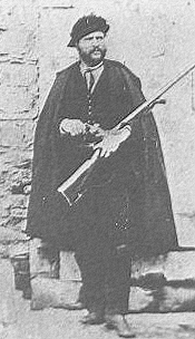
Photograph of the “ Totaro” whose actual name was Vincenzo Di Gianni
The photograph below is of “Totaro’s” San Felese insurgent group including another San Felese insurgent leader known as “Tinna” whose real name was Fransesco Fasanello. I think “Tinna” is standing to Totaro’s right in the photograph.
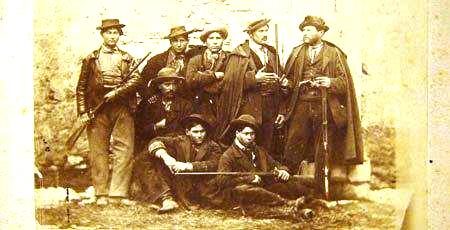
Photograph of Totaro’s San Fele banda taken in 1865
As a last remark in this article I should point out that Lucanian women in this conflict eventually began to play much more than just a supporting role. Below are some photos of so-called brigantesse.
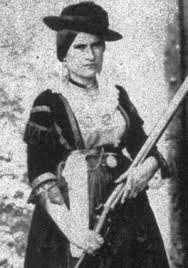
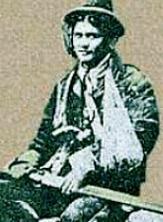
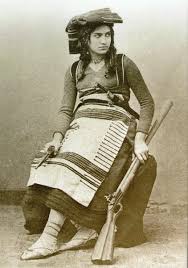
Photographs of Brigantesse